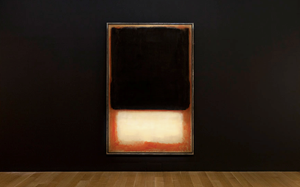
Mark Rothko's Monumental Canvas No. 7 (Dark Over Light), 1954 to Highlight Christie's Evening Sale of Post-War and Contemporary Art.
Mark Rothko’s monumental canvas, No. 7 (Dark Over Light), 1954, will highlight the May 17 Evening Sale of Post-War and Contemporary Art in New York (estimate in the region of $30million). At nearly eight feet tall, No. 7 (Dark Over Light) belongs to a select group of canvases that were among the largest that Rothko ever painted. Its grand scale is matched only by the emotional intensity of its painted surface. Such a highly active painterly surface is a mark of Rothko’s paintings from this important period, but it is the scale on which it has been executed in No. 7 (Dark Over Light) that makes this particular work one of the most extraordinary; its broad sweeps and feathered edges reveal the artist’s ambition to create a pure and direct form of painting. No. 7 (Dark Over Light) is being offered at auction for the first time in over a decade.
Rothko’s stated aim was to dissolve the traditional, and what he thought of as artificial boundaries, between paint and canvas, between painter and idea, and ultimately between the idea and the observer. To the artist, what the viewer saw was not a depiction an experience, it was the experience, and to this end he championed what he considered to be the two fundamental elements of picture making—space and color—making these the sole protagonists of his aesthetic drama. Reaching its height in his iconic Seagram Murals, this painterly struggle dominated Rothko’s work for a little over a decade, as in 1968, on the instructions of his doctors, he was forced to retreat into making smaller paintings, often no larger than 40 inches. As a result, works such No. 7 (Dark Over Light) represents the fullest and purest expression of Rothko’s unique artistic vision, one whose visual and emotional power is present in abundance in this magisterial canvas.
No. 7 (Dark Over Light) belongs to a small group of paintings that Rothko executed in the mid-1950s which feature large passages of predominately dark, moody color. Primarily, his paintings from this period are known for the triumphant schema of fiery reds, golden yellows and deep oranges. But in a handful of canvases he also introduced opposing hues, such as can be seen in the present work along with Untitled (Violet, Black, Orange on Gray), 1953 (National Gallery of Art Washington), No. 203 (Red, Orange, Tan and Purple), 1954 and Untitled (Red, Black, White on Yellow), 1955 (also in the collection of the National Gallery of Art, Washington, D.C.). These dark paintings reflected not so much a "darkening" of Rothko's mood as a deepening of feeling.
In addition to color, size was also an important factor in Rothko achieving the necessary emotional intensity that he desired. As he explained, “I paint very large pictures. I realize that historically the function of painting large pictures is painting something very grandiose and pompous. The reason I paint them, however—I think it applies to other painters I know—it is precisely because I want to be very intimate and human. To paint a small picture is to place yourself outside you experience, to look upon an experience as a stereopticon view or with a reducing glass. However, you paint the larger picture, you are in it. It isn’t something you command.”
No. 7 (Dark Over Light) was first acquired by Count Alessandro Panza di Biumo, Sr. in 1961. He was the brother of the legendary Count Giuseppe Panza di Biumo, widely considered to be one of the most important collectors of postwar American Art. Works from the elder Panza di Biumo’s holdings later formed the basis for the collection of the Los Angeles Museum of Contemporary Art, and in the 1990s, the Solomon R. Guggenheim Museum filled a yawning gap in its holdings when it acquired, in a combined gift and purchase arrangement, more than 300 Minimalist sculptures and paintings from the collection.

ArtDependence Magazine is an international magazine covering all spheres of contemporary art, as well as modern and classical art.
ArtDependence features the latest art news, highlighting interviews with today’s most influential artists, galleries, curators, collectors, fair directors and individuals at the axis of the arts.
The magazine also covers series of articles and reviews on critical art events, new publications and other foremost happenings in the art world.
If you would like to submit events or editorial content to ArtDependence Magazine, please feel free to reach the magazine via the contact page.